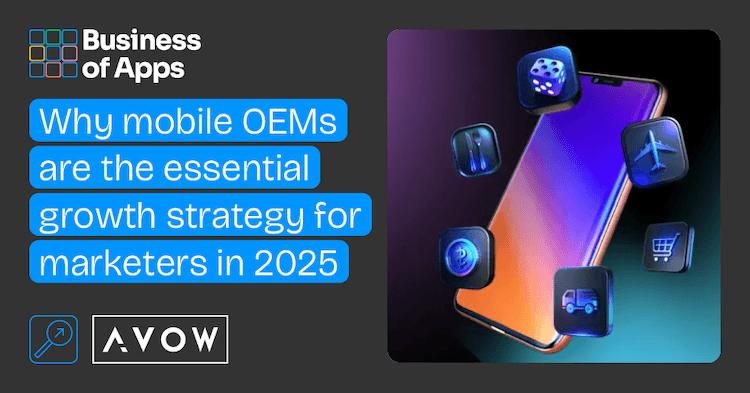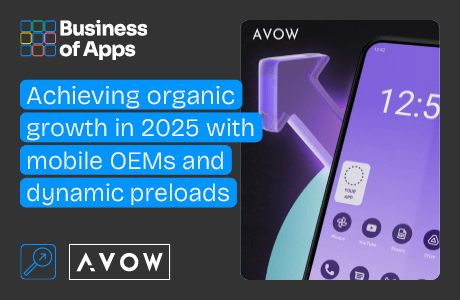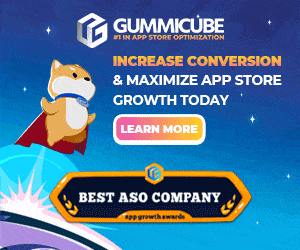Mobile Original Equipment Manufacturers (OEMs) such as Samsung, Xiaomi, Huawei, OPPO, and Vivo are reshaping mobile marketing through their alternative app stores and advertising platforms. These channels are vital for growth in the mobile landscape. With nearly half of Android app store expenditure coming from alternative sources, OEM channels offer cost-effective, highly targeted ways to reach new users. Incorporating them into your marketing mix allows for greater reach, engagement, and adaptability in an increasingly competitive environment.
An overview of mobile OEMs
Before exploring the advantages, it’s vital to truly grasp what mobile OEMs are. So let’s spell it out. Simply put, they’re companies that make mobile smartphones. Beyond hardware, many OEMs have also entered the software market, introducing their own app stores and advertising platforms. These are distinct from mainstream counterparts like Google Play. Moreover, these alternative app stores have shaken things up too. The magnitude of this shift can be seen in the numbers. By the end of 2022 alternative app stores broke $39 billion in revenue. With a burgeoning user base and heightened engagement, mobile OEMs are a worthy option to consider.
8 Reasons to integrate mobile OEMs into your mobile marketing growth strategy
The increasing fragmentation of the app store ecosystem might seem like a challenge, but in reality, it’s full of opportunities. Let’s explain why:
Mobile OEMs have a global reach
For brands aiming to penetrate diverse markets throughout the world, mobile OEMs offer an unprecedented edge. In Asia and other emerging markets, local mobile OEM app stores often overshadow their global counterparts, providing an essential gateway for regional expansion. This trend is also picking up pace in EMEA and LATAM, with several mobile OEMs now operating local alternative app stores in the region, and plans for greater expansion forging ahead. But make no mistake, this extends beyond alternative app stores and into on-device ad inventory present within each mobile OEM as well. This could be advertising within the launcher, app drawer, native apps and so much more.
OEM advertising keeps your budget in check
App store giants like Google might be successful, but their services are expensive. Competitive bidding wars have escalated advertising costs on these platforms, making them less competitive. Conversely, mobile OEM platforms are more cost-effective. Reduced competition translates to lower user acquisition costs, maximizing return on investment. Another key differentiator is that mobile OEMs operate on a performance-based cost-per-install model, moving away from the traditional cost-per-click model.
Brand safety and fraud-free traffic go hand in hand
With no additional layers between users and advertisers, mobile OEMs make fraud virtually impossible. As a result, advertisers are finding mobile OEMs to be a trustworthy channel—and an efficient way to spend their budget.
OEMs offer extensive targeting
In a commercial era defined by big data, precision targeting is paramount. With their extensive insight into user habits, mobile OEMs allow marketers to craft hyper-personalized campaigns for alternative app stores or Google Play Store. Such precision both amplifies engagement as well as enhances conversion rates. Moreover, advertisers also have the flexibility to select the download destination for display campaigns. As privacy regulations evolve, the advent of the Open Anonymous Device Identifier (OAID) ensures marketers can maintain their targeted approaches while upholding user privacy.
Alternative App Store’s Dynamic Preloads mean users at your fingertips
Imagine a scenario where users turn on their brand-new phone and their first recommended download is your app. Sounds good, right? The visibility and immediate user base offered by mobile OEMs’ dynamic preloads are unparalleled. It’s akin to having a shop in the heart of town. Another bonus is that Dynamic preloads via Google Play Auto Install (PAI) are sourced directly from the Google Play Store, eliminating the need for your app’s presence on other platforms.
OEMs are integrated with MMPs
The backbone of any successful campaign is its analytical prowess, and integration with leading attribution platforms ensures marketers aren’t flying blind. Every decision is data-backed, meaning campaigns evolve in real time, optimizing for maximum efficacy.
Fire Up Your Growth!
Moburst propelled leading brands like Google, Reddit, and Uber to the next level. Let’s ignite your Success journey today!
Claim Your FREE Growth Fuel!Monetization and freedom of choice
Diversification often entails anxieties derived from complex arrangements. Accustomed to the monetization strategies of conventional platforms, app developers might view mobile OEMs with skepticism. The transition to alternative app stores, however, is, in fact, seamless. The freedom of choice that mobile OEMs provide allows app developers to negotiate their revenue share deal with the OEMs and determine how they would like to monetize.
Ease of use
For app developers looking to monetize only with ads, who do not require implementing a payment solution, or who are only interested in publishing their apps on App stores without their own payment solution, getting started with alternative app stores is easy. All that is needed to do is to upload the app onto the store; no tweaking or special app versions are required. There is no need to be daunted by needing to maintain multiple app versions across multiple app stores, as OEMs now offer a built-in auto-update functionality, which maintains the app version in line with what has been uploaded to Google Play. With the right tools and guidance, setting up shop across various app stores while leveraging tried-and-tested monetization methods is a cinch.
Are there any challenges with mobile OEMs?
As with anything, mobile OEMs do present several challenges one should be aware of before embarking on this journey.
Fragmentation and choice paralysis of mobile OEMs
There are many mobile OEMs around, and with that comes fragmentation. Each OEM has their own offerings and strengths, as well as their own alternative app stores. For a mobile marketer dipping their toes into mobile OEMs for the first time, it can seem daunting and a little confusing as to which mobile OEM to choose, or how many of them to go with.
Understanding mobile OEM market dynamics and geographies
Not all geographies are equal, and the strength of mobile OEMs varies significantly by region. As of September 2024, Samsung commands nearly 32% of the European market, while Xiaomi holds almost 14%. In Asia, brands like Xiaomi, Vivo, and OPPO collectively account for about one-third of the mobile market. In India specifically, Xiaomi captures nearly 20% of the market share. For mobile marketers unfamiliar with these dynamics, understanding what works and where is essential for developing effective strategies.
Thankfully, most if not all of these challenges can be alleviated with the right agency partner who understands mobile OEMs and the nuances of the industry.
Takeaway: Alternative App Stores are the new mainstream
What’s clear is that Mobile OEMs aren’t just a niche. Although their presence in the mobile marketing landscape is evolving, the advantages of alternative app stores are impressive, undeniable, and now part of the mainstream. A recent data.ai report shows that alternative app stores now account for almost half of all Android app store expenditure.
In a saturated commercial environment, mobile OEMs also offer brands the chance to stand out and connect with new users through personalized, targeted messaging.
This is not about numbers and strategy: it’s about resonating with the end user. As such, the writing is on the wall. Mobile OEMs are now part and parcel of the mainstream and a prime example of why marketers need to keep an eye on the evolution of the industry so they can continue to adapt, innovate, and thrive.
So, as we stand at the crossroads between old traditional models and the new, ask yourself this. Are you ready to make mobile OEMs a part of your mobile growth strategy?












